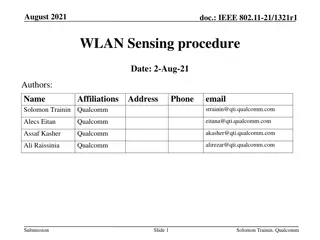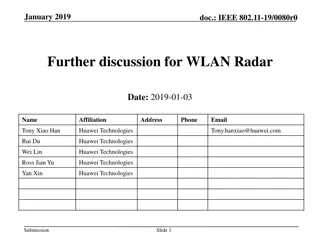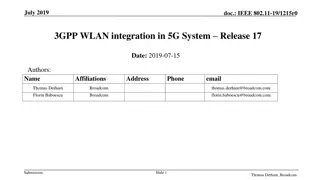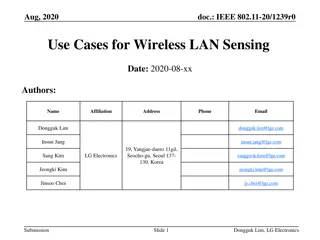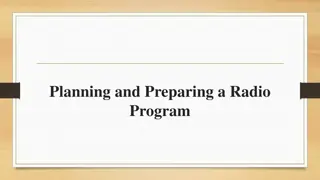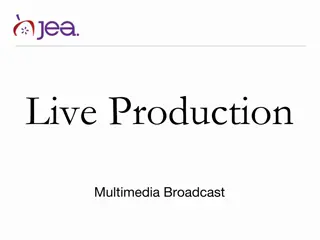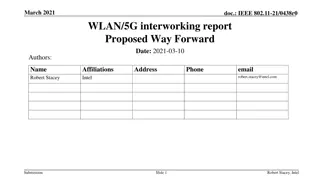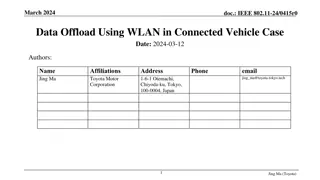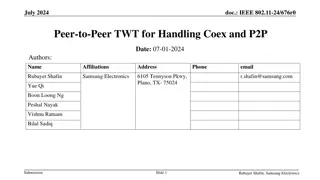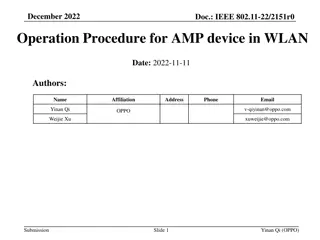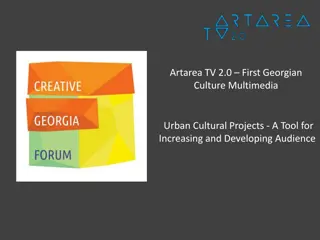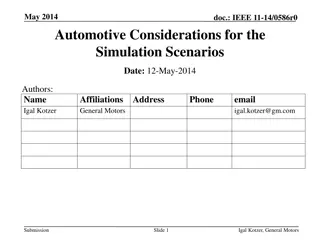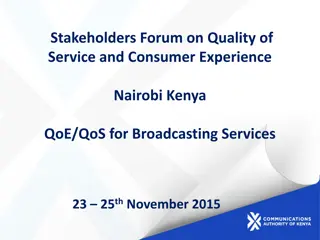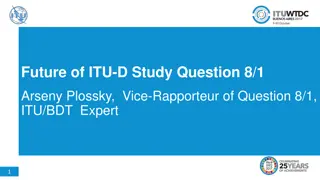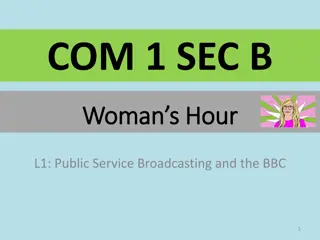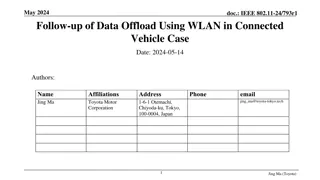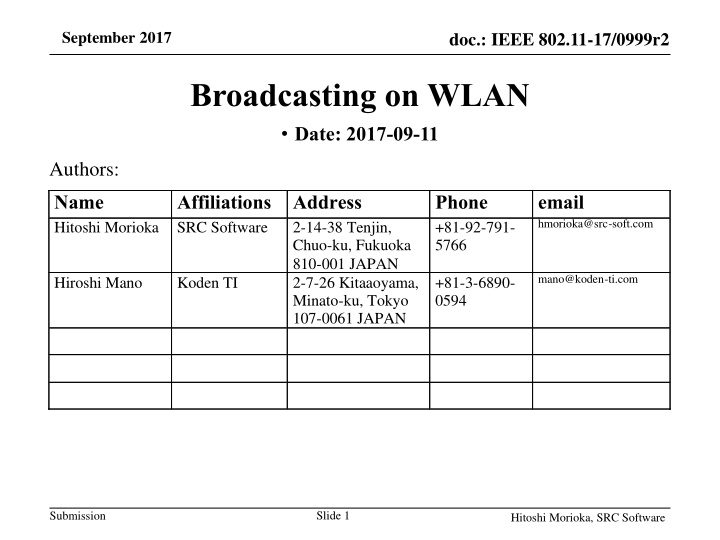
Local Broadcasting Proposal on WLAN for Efficient Information Sharing
Describing a proposal for broadcasting local information on WLAN to enhance efficiency and reduce bandwidth waste. The presentation highlights the need for common information dissemination at specific locations and the advantages of utilizing WLAN for broadcasting services. Various use cases such as audio guidance and digital signage are discussed, emphasizing the potential benefits of implementing this broadcasting approach.
Download Presentation

Please find below an Image/Link to download the presentation.
The content on the website is provided AS IS for your information and personal use only. It may not be sold, licensed, or shared on other websites without obtaining consent from the author. If you encounter any issues during the download, it is possible that the publisher has removed the file from their server.
You are allowed to download the files provided on this website for personal or commercial use, subject to the condition that they are used lawfully. All files are the property of their respective owners.
The content on the website is provided AS IS for your information and personal use only. It may not be sold, licensed, or shared on other websites without obtaining consent from the author.
E N D
Presentation Transcript
September 2017 doc.: IEEE 802.11-17/0999r2 Broadcasting on WLAN Date: 2017-09-11 Authors: Name Hitoshi Morioka SRC Software Affiliations Address Phone +81-92-791- 5766 email hmorioka@src-soft.com 2-14-38 Tenjin, Chuo-ku, Fukuoka 810-001 JAPAN 2-7-26 Kitaaoyama, Minato-ku, Tokyo 107-0061 JAPAN mano@koden-ti.com Hiroshi Mano Koden TI +81-3-6890- 0594 Slide 1 Submission Hitoshi Morioka, SRC Software
September 2017 doc.: IEEE 802.11-17/0999r2 Abstract This presentation describes a proposal of broadcasting on WLAN. Slide 2 Submission Hitoshi Morioka, SRC Software
doc.: IEEE 802.11-17/0999r2 September 2017 Motivation Many people need common information at specific locations, such as Live comments at a stadium, Explanation at a tourist attraction, Timetable at a train station, Floor plan at a shopping mall, or Emergency information. We call them local information in this presentation. Currently people need to do the following actions. Search web site. Get the local information by unicast traffic. These actions waste channel time/bandwidth. Broadcasting local information on WLAN can reduce per user bandwidth. Slide 3 Submission Hitoshi Morioka, SRC Software
doc.: IEEE 802.11-17/0999r2 September 2017 Broadcasting Service on WLAN WLAN is a suitable medium for local broadcasting service, but it is not used. Radio wave is suitable for broadcasting based on its nature. Anyone can listen in the range. Frequently changed information, such as vacant space at a parking lot, can be reflected in real time. IEEE802.11 WLAN has broadcast mechanism (group address) Unlicensed Locality Low cost Currently used broadcasting services on WLAN, such as YouTube Live, Facebook Live Application layer broadcasting It is composed of many independent unicast streams in a single BSS. The occupied bandwidth is proportional to the number of participating users. The current model suffices if users are distributed world-wide, but works highly inefficiently when they are located in a small area. Slide 4 Submission Hitoshi Morioka, SRC Software
doc.: IEEE 802.11-17/0999r2 September 2017 Use Case 1 (Audio Guidance) AP Train STA Anyone in stadium, museum or zoo who has a smartphone can listen audio guidance/comments without additional hardware. Multiple logical channels can be used. Multilingual broadcasting can be supported on a single radio channel. Of course, any type of data can be broadcast, such as video, text, HTML Hitoshi Morioka, SRC Software Slide 5 Submission
doc.: IEEE 802.11-17/0999r2 September 2017 Use Case 2 (Floor Guide, Timetable, Advertisement) AP Train STA Smartphone Digital Signage Device Anyone in a shopping mall, conference venue like here, who has a smartphone can see the floor guide on their device. Anyone in a train station who has a smartphone can see the timetable on their device. Digital signage device in the area can show the same information. Hitoshi Morioka, SRC Software Slide 6 Submission
doc.: IEEE 802.11-17/0999r2 September 2017 Use Case 3 (Emergency Information) Broadcasting infrastructure can be used for distributing emergency information such as: Evacuation guidance in case of fire. Earthquake warning. Food information in a shelter. Hitoshi Morioka, SRC Software Slide 7 Submission
doc.: IEEE 802.11-17/0999r2 September 2017 Security Requirements To prevent fake information distribution, the source of information shall be identified. Because of dense deployment in the assumed use cases, the fake AP causes a disruption of the services. Every broadcast frame shall be authenticated by the receivers. Encryption may be optional. Most broadcasting contents are considered as public and preferred to be widely distributed. Hitoshi Morioka, SRC Software Slide 8 Submission
doc.: IEEE 802.11-17/0999r2 September 2017 Current Broadcast Security on WLAN Required to join GTKSA. GTK and Key RSC are shared by EAPOL-key or, in case of 802.11ai, Key Delivery element in Association Response. Current GTKSA uses AES, a kind of Symmetric-key algorithm . An AP and non-AP STAs in a GTKSA shares the same GTK and Key RSC/TSC. The AP encrypts broadcast frames by using the GTK and the Key TSC. The non-AP STA decrypts broadcast frames by using the GTK and the Key RSC. This means Any STAs which can decrypt broadcast frames can produce encrypted broadcast frames . So a malicious user can produce fake broadcast frames. The receivers can NOT check the integrity of broadcast frames. Encrypt (GTK, TSC) AP AP Mac address spoofing malicious STA STA STA STA Decrypt (GTK, RSC) Decrypt (GTK, RSC) Decrypt (GTK, RSC) STA STA Encrypt (GTK, RSC) Decrypt (GTK, RSC) Decrypt (GTK, RSC) Hitoshi Morioka, SRC Software Slide 9 Submission
doc.: IEEE 802.11-17/0999r2 September 2017 QoS Considerations QoS for broadcast frames In general, the loss rate of broadcast frame is higher than unicast frame. Broadcast does not have ACK mechanism. Existing 802.11 uses BCC/LDPC. Is required stronger FEC/Interleaving algorithm? Consider to apply 802.11aa GCR mechanism. In this case, association to AP is required. QoS for other .11 frames How much bandwidth can be used for broadcasting? Define limit of bandwidth? Adaptive control? Consider to apply 802.11aa OBSS management. Hitoshi Morioka, SRC Software Slide 10 Submission
doc.: IEEE 802.11-17/0999r2 September 2017 Amendment Proposal to the Existing Standards AP STA Add new broadcast mechanism. Each frame can be authenticated without any transmissions of non-AP STAs. Without existing Authentication/Association. Define new class 1 broadcast data frame. Key Data + Authenticator Data + Authenticator Data + Authenticator Data + Authenticator Data + Authenticator Limit the receivers by the existing GTKSA mechanism Encrypt the key and data. AP STA encrypt(Key) encrypt(Data + Authenticator) encrypt(Data + Authenticator) encrypt(Data + Authenticator) encrypt(Data + Authenticator) encrypt(Data + Authenticator) Hitoshi Morioka, SRC Software Slide 11 Submission
doc.: IEEE 802.11-17/0999r2 September 2017 Conclusion Broadcasting on WLAN can improve user experience. For broadcasting on WLAN: Define Class 1 broadcast data frame Consider QoS mechanism. Define frame authentication mechanism It s time to start work for broadcasting Because we can assign IEEE802.11bc for broadcasting! Hitoshi Morioka, SRC Software Slide 12 Submission
doc.: IEEE 802.11-17/0999r2 September 2017 Comments & Questions Hitoshi Morioka, SRC Software Slide 13 Submission
doc.: IEEE 802.11-17/0999r2 September 2017 Straw poll Do you support to form study group for broadcasting on WLAN ? Yes: No: Don t care: Need more info: Hitoshi Morioka, SRC Software Slide 14 Submission

